Step by Step on The Way of Saint James
From Frómista to Carrión de los Condes
26 May 2018
Stage 16 – 19 km
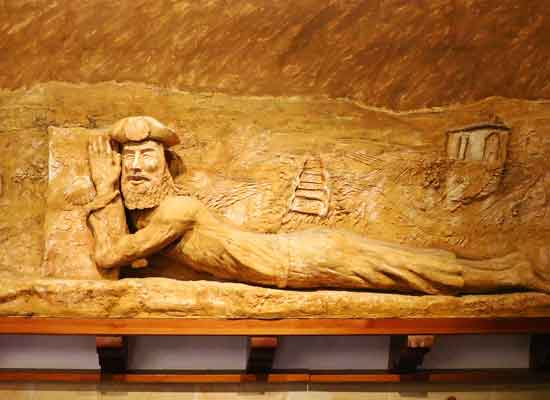
As soon as I wake up, my first concern is to assess the condition of my legs.
The pain hasn’t completely subsided, but compared to yesterday, it’s less intense. I think I can bear it if it stays at this level.
Fortunately, today’s stage is shorter than usual; the total length doesn’t even reach twenty kilometers.
Given that we have fewer hours of walking, we can afford to start a little later this morning than usual.
Moreover, we take advantage of breakfast served at the hostel, which only costs 3 Euros.
Given my not-so-great physical condition, today’s plan works well as a softer stage without needing any adjustments.
We leave the hostel at 7:15.
I suggest to Rocco and Dante that they go ahead at their own pace without waiting for me. After all, we can meet up along the way, at intermediate stops, or at the final destination.
I prefer to proceed at a slower pace so as not to strain my legs too much.
As for the weather, the sky is still cloudy, but the cold isn’t too intense.
– Once again, the “mesetas” spare us the scorching heat they are known for and often feared for. –
Leaving Frómista, we cross an overpass that allows us to bypass the Cantabria-Meseta motorway. Immediately after, The Way continues along a dirt path running parallel to the paved road.
For Dante, situations like this are ideal, as he can drag his cart more easily, progressing along the smooth asphalt.

The perfectly straight paved road and the parallel dirt track cut through the usual barren meseta landscape.
There are no tall trees, only endless fields of cereals stretching as far as the eye can see.
As I’ve already mentioned, this typical steppe plateau extends from Burgos to León.
Many people choose to skip this part of the French Way, taking a bus that connects the two major cities.
This is a suggestion I’d offer to those who don’t have more than a month to complete the entire route on foot.
However, if time isn’t an issue, my advice is to walk through this section as well.
Although the landscapes may be monotonous and challenging, they contribute to the full experience of The Way. The peace, silence, and wide-open views are rewarding.
Moreover, walking such long distances in the middle of nowhere gives you the freedom to let your mind wander and reflect on life from different perspectives.
– Meditation forces you to listen to thoughts that are usually drowned out by the hectic pace of everyday life. –
Finally, experiencing suffering can serve as an opportunity for inner growth. By reacting to negative events with detachment, you learn not to add mental anguish to physical pain.
***
Around eight o’clock, we reach Población de Campos.
From here to Villarmentero de Campos, there’s an option to follow an alternative route to the main one.
The advantage of this detour, although slightly longer, is that it passes through a more shaded area.
Since the sky is overcast and we don’t have to worry about direct sunlight, we decide to stick to the main road.
Thus, shortly after the small village of Población de Campos, we cross the río Ucieza via a seven-arch Baroque bridge built in the 17th century.
The pain in my shins intensifies during the three kilometers leading to Revenga de Campos.
I take the opportunity to rest and take some anti-inflammatory medication when we arrive in the small village.
Despite the discomfort, I don’t miss the chance to look around.
I notice the exterior of the 13th-century iglesia de San Lorenzo. Its bell tower has a large nest with a pair of storks.
In one corner of the plaza General del Amor, there’s a metal statue of an ancient pilgrim, erected to celebrate the Holy Year of Saint James in 2004.
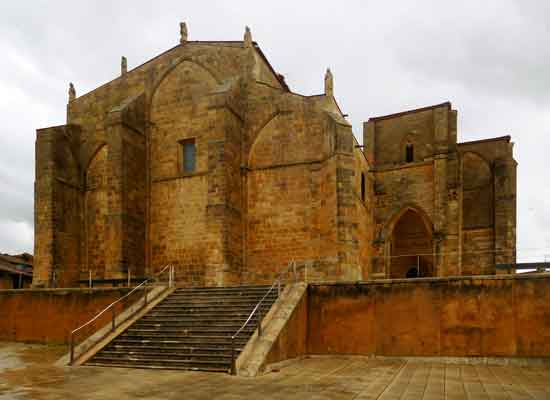
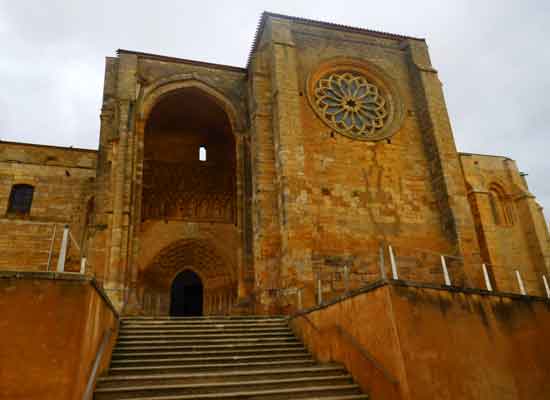
Meanwhile, as if my physical aches weren’t enough, it starts raining heavily, making The Way even tougher.
I put on my poncho, which also covers my backpack, and wear gaiters to protect my shoes from water seeping in.
Dressed like this, I resume walking shortly after nine. Since I’ve slowed down, my friends have gone ahead, leaving me alone in the middle of nowhere.
The pouring rain accompanies me for almost the entire six and a half kilometers to the next village, making the journey particularly painful.
When I arrive at Villalcázar de Sirga, the rain has just stopped. I take the chance to visit the iglesia de Santa María la Blanca, which is marked as “unmissable” in the guides.
Externally, the Romanesque/Gothic church from the 13th century impresses with its massive structure and imposing fortified arched portal.
The portal features sculptures of Christ Pantocrator, the Annunciation, and the Epiphany. The interior also houses many wonderful works.
The church is particularly famous for the miraculous healings of pilgrims attributed to the image of the Virgin inside.
In the large square in front of the church, there’s a recently crafted iron statue depicting a pilgrim seated at an inn table.
To commemorate my painful moment, dressed like an old-time traveler, I ask a passerby to take a photo of me next to the iron pilgrim.

I stop at a bar right in front of the monumental church before setting off again.
To regain some strength, I order a long coffee and a chocolate roll, which I stubbornly call “pan chocolate.” However, here in Spain, it’s known as “Napolitana,” a clear reference to the Neapolitan city.
Leaving the village, I catch up with Rocco and Dante. They are completely drenched from the rain, and Dante, wearing only a lightweight jacket, is soaked from head to toe.
Moreover, wet as they are, they’re also feeling very cold.
Given their condition, they decide to take a taxi to the final destination of today’s stage, even though only six kilometers remain.
Despite my pain, I politely decline their invitation to join them in the taxi.
– As long as I can walk on my own legs, I want to complete The Way of Saint James entirely on foot. –
The two of them, however, are not overly concerned with sticking to the purist approach and leave in a taxi without hesitation.
It’s 11:20, and as I resume walking, the rain starts falling heavily again.
Fortunately, the anti-inflammatories I took earlier are kicking in, allowing me to pick up the pace slightly.
About a kilometer and a half from today’s final stop, I meet an Australian woman also walking towards Santiago de Compostela.
By then, the rain has stopped, and we continue together, chatting pleasantly until we reach our destination.
At 12:30, the Australian woman and I arrive in Carrión de los Condes, stopping specifically at the Real Monasterio de Santa Clara hostel, located at the entrance to the town.
The monastery, founded in the 13th century by disciples of Saint Clare of Assisi on pilgrimage to the Apostle James’s tomb, is one of the oldest Franciscan communities in Spain.
For centuries, the nuns have practiced Franciscan hospitality, and even today, part of the monastery serves as a pilgrim hostel with just about thirty beds available.
The monastery’s fame also comes from its interesting museum of artistic objects and a collection of nativity scenes from around the world.
Among the various statues adorning the entrance facade, one depicts Saint Francis of Assisi.
When I arrive at the monastery, I find Rocco waiting for me. He tells me he has reserved a room just for the three of us.
Since they arrived by taxi, Rocco and Dante have already showered and eaten a snack.
– Thanks to my thoughtful Way companions, I already have a bed waiting for me. –
The Australian woman who arrived with me also finds a bed and is lucky because it’s the last one available.
I, too, take a hot shower and then finally get to stretch out on the bed and relax for a couple of hours.
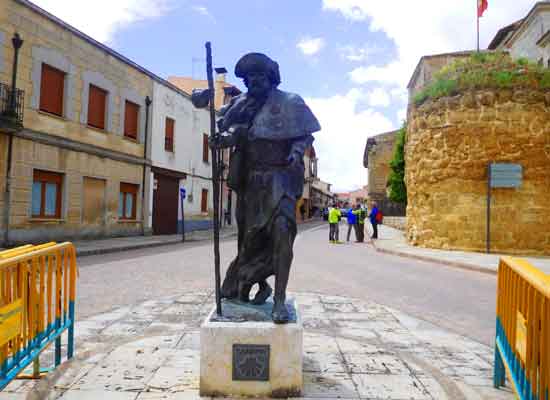
Around four in the afternoon, I head out to explore the town and meet up with Rocco and Dante, as planned.
When I arrive, I find them chatting with three people from Tuscany whom they’ve just met at the hostel.
The new pilgrim friends suggest having dinner together and offer to shop for ingredients and prepare a proper carbonara.
We gladly accept the invitation.
As I’ve mentioned before, groups that form on The Way are “fluid.” While new friends appear, others you met earlier disappear from sight.
Today we met the group from Tuscany, but on the other hand, I haven’t seen many of the people I shared the first stages with for quite some time.
For instance, I’ve lost track of Franco and Peppe, the two Neapolitans I first met at Naples airport; Fernando, the nearly eighty-year-old Argentine marathon runner and “Casanova”; Anna, the lively French senior who kept overtaking me throughout the day; and the charming mother-daughter duo, also French.
I’m particularly sad about losing contact with the friendly Spaniards Juanì and Salvador, who stayed an extra day in Burgos due to Salvador’s ankle tendonitis.
However, I still see Maria from Alba, with whom we prepared the infamous microwave pasta in Zubiri.
I come across her every morning striding ahead, like all those with long legs.
Each time we exchange a quick chat before she moves on, and I lose sight of her for the rest of the day.
Then, when I reach the hostel, I find her already eating after shopping and cooking.
Not a day goes by without Maria and her new Galician walking companion preparing a massive plate of pasta and a hearty second course to recover from the day’s effort.
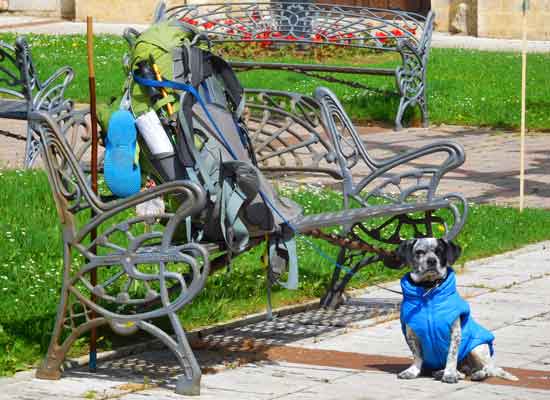
***
In the afternoon, the weather in Carrión de los Condes improves, and a few rays of sunshine warm us up a little, although the temperature doesn’t rise much.
I’m still struggling to walk and probably should have stayed in bed, but I don’t want to miss the chance to explore the town.
There’s a lot of activity in the center: the main square is lively, with several bars offering outdoor seating.
I see many pilgrims and plenty of locals as well.
Carrión de los Condes, located near the río Carrión, has been an important stop along the French Way to Santiago de Compostela since ancient times.
The town features several significant medieval religious buildings, four of which we visit during our walk.
The 12th-century Romanesque iglesia de Santa María del Camino features sculptures of maidens and bulls above the main entrance. These symbolize the legend of the “hundred young girls.”
According to the story, as the girls were being handed over as tribute to the Moors, the Virgin Mary made bulls appear, scaring away the attackers and freeing the girls.
For this reason, the church is also known as Santa María de las Victorias.
The 12th-century Romanesque iglesia de Santiago stands out for its richly sculpted facade.
The middle archivolt displays scenes of crafts, trades, and warfare, while the frieze above it features Christ Pantocrator flanked by evangelists and apostles.
The iglesia de San Andrés Apostol, built in Renaissance style in the 16th century, was constructed on the site of an even older church.
The sanctuary of Nuestra Señora de Belén, rebuilt between the 16th and 17th centuries, stands at the highest point in town, overlooking the fertile plain crossed by the río Carrión.
Inside, its main altar is adorned with a large Renaissance-style altarpiece.
While touring the town, we mix cultural exploration with practical tasks.
In a sports shop, I buy closed shoes as an alternative to the flip-flops I already have.
We also stop by a supermarket to pick up food for the following day.
Finally, I return to the hostel to rest a bit more, as the walk around town has aggravated my leg pain.
In the evening, we have dinner at the hostel with our new friends from Tuscany.
Of the three, Graziano takes on the role of chef and, as promised, prepares a generous carbonara.
We accompany the meal with lively conversation about The Way and beyond, finishing with a large tomato salad.
In the end, the dinner costs just 3 Euros each.
Personally, I still believe it’s better to spend a little more and go out for a “pilgrim’s menu,” which is usually more filling and, above all, more varied.
| © Aldo Lardizzone 2020 |  |
CREATIVE COMMONS |



